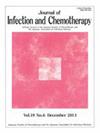脐带血移植成功治疗急性髓系白血病伴eb病毒相关噬血细胞淋巴组织细胞增多症1例。
IF 1.5
4区 医学
Q3 INFECTIOUS DISEASES
引用次数: 0
摘要
噬血细胞性淋巴组织细胞增多症(HLH)是一种危及生命的高炎症综合征。eb病毒(EBV)感染是HLH的常见病因。偶尔,HLH发展与恶性肿瘤,如淋巴瘤;急性髓性白血病(AML)和ebv相关的HLH (EBV-HLH)并发病例非常罕见,治疗方法尚未建立。造血干细胞移植(HSCT)是治疗难治性HLH和高危AML的唯一方法。因此,HSCT将是HLH和高风险AML共存病例的良好治疗方法。一名66岁男性被诊断为高风险AML。诱导化疗后,患者出现长时间全血细胞减少、高热、肝酶升高。发现EBV病毒载量高,诊断为EBV- hlh, EBV感染CD8+ t细胞。EBV-HLH通过皮质类固醇治疗得到缓解。同时,巩固化疗后仍有部分噬血现象,全血EBV-DNA阳性。患者接受脐带血移植治疗AML和EBV-HLH。他的急性髓性白血病完全缓解,噬血细胞症缓解。然而,移植后53天,他的EBV病毒载量再次增加。EBV感染发生在b细胞中,无噬血症复发。总之,移植治疗AML和HLH均成功。本报告强调了AML和EBV-HLH共存的具体病例的治疗策略。本文章由计算机程序翻译,如有差异,请以英文原文为准。
A case of acute myeloid leukemia with Epstein-Barr virus-associated hemophagocytic lymphohistiocytosis successfully treated by cord blood transplantation
Hemophagocytic lymphohistiocytosis (HLH) is a hyperinflammatory life-threatening syndrome. Epstein-Barr virus (EBV) infection is a common cause of HLH. Occasionally, HLH develops with malignancies such as lymphoma. Concurrent cases of acute myeloid leukemia (AML) and EBV-associated HLH (EBV-HLH) are very rare, and the treatment has not been established. Hematopoietic stem cell transplantation (HSCT) is the only curative treatment for refractory HLH and high-risk AML. Consequently, HSCT would be a good treatment for cases of HLH and high-risk AML coexistence. A 66-year-old man was diagnosed with high-risk AML. After induction chemotherapy, he experienced prolonged pancytopenia, high fever, and elevated liver enzymes. A high EBV viral load was found, and he was diagnosed with EBV-HLH, with EBV infecting CD8+ T-cells. EBV-HLH was resolved by treatment with corticosteroids. Meanwhile, some hemophagocytosis remained after consolidation chemotherapy, and EBV-DNA in whole blood was positive. The patient received cord blood transplantation to treat both AML and EBV-HLH. His AML achieved complete remission, and the hemophagocytosis was in remission. However, his EBV viral load increased again 53 days after transplantation. Then, the EBV infection occurred in B-cells, and there was no relapse of hemophagocytosis. In conclusion, both AML and HLH were successfully treated by transplantation. This report highlights treatment strategies in specific cases of AML and EBV-HLH coexistence.
求助全文
通过发布文献求助,成功后即可免费获取论文全文。
去求助
来源期刊

Journal of Infection and Chemotherapy
INFECTIOUS DISEASES-PHARMACOLOGY & PHARMACY
CiteScore
4.10
自引率
4.50%
发文量
303
审稿时长
47 days
期刊介绍:
The Journal of Infection and Chemotherapy (JIC) — official journal of the Japanese Society of Chemotherapy and The Japanese Association for Infectious Diseases — welcomes original papers, laboratory or clinical, as well as case reports, notes, committee reports, surveillance and guidelines from all parts of the world on all aspects of chemotherapy, covering the pathogenesis, diagnosis, treatment, and control of infection, including treatment with anticancer drugs. Experimental studies on animal models and pharmacokinetics, and reports on epidemiology and clinical trials are particularly welcome.
 求助内容:
求助内容: 应助结果提醒方式:
应助结果提醒方式:


